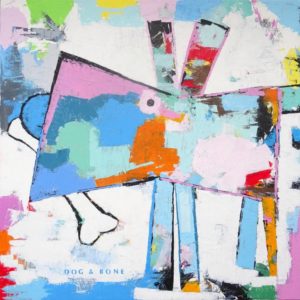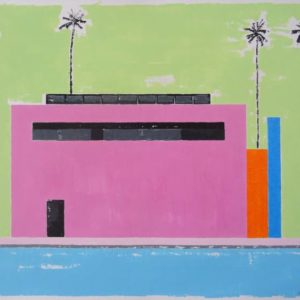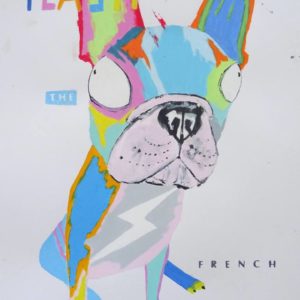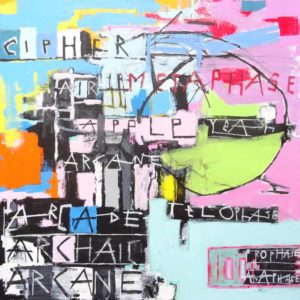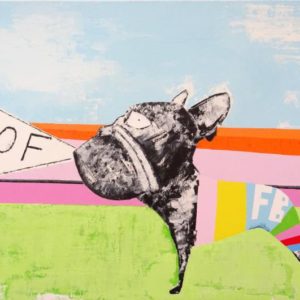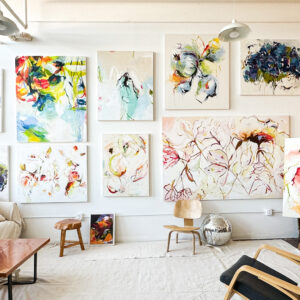Inside the Studio
 Andy Shaw Creates Colorful Multimedia Works Inspired by Popular Culture
Andy Shaw Creates Colorful Multimedia Works Inspired by Popular Culture
What are the major themes you pursue in your work?
The pursuit can be wide ranging, as an artist I look at the whole: life, death, the universe, and everything in between. We live in an information society, the ever expanding and interconnectedness of media messages can take multiple routes into our lives.
I grew up through two of the most important music phenomenons in history: punk in the late ’70s as a teenager and rave/acid house in the late ’80s while at University in Manchester and going to ‘The Hacienda’ club. The do-it-yourself mentality of the designs and graphics in flyers or record covers was, and still is an important influence. That mentality is central to my work.
I also draw inspiration from popular culture. Extracting ideas from music, sports, design, architecture, advertising, film and T.V., which all lead to a convergence point. My work criss-crosses the boundaries of pop art, abstract, graffiti and realism – call it contemporary art!
In regards to my practice, a few years ago I made a dog drawing and ran with it. A dog is for life, not just for Christmas, and so is a work of art. There’s a cartoonish humorous element with my dog works such as, dogs named after famous artists and dressed up in snazzy clothing. It’s a reflection of what we can do to our most prized possession. I have also made sculptural pieces in the past and a range of sculptural ceramics by incorporating a blitz of scribbled messages and logos. In 1995 while working in Shoreditch, London, I made a sculpture incorporating a spinning plastic brain inside a cylinder submerged in water. As the cylinder rotated, the water would rise stretching and distorting the plastic brain inside: cerebral stretched parameters. I was pleased when David Bowie visited my show and bought the sculpture.
What was the best advice given to you as an artist?
Advice can come in many shapes and forms, as the business of selling art and making art are two different areas. From an artist and ‘manager’ perspective both belief and conviction are important. And I believe that as an artist no one can tell you what to paint, make or draw. Also, be prepared to make mistakes and discover something new. The environment and the world as it is, almost dictates to a certain extent what we do – lifestyle and choices. How would our work change if trapped on a deserted island? Or going off on a world cruise for a year or two for instance.
The Francis Bacon interviews with David Sylvester are a great insight into Bacon’s working mind and the life of an artist. The interview also provides great advice. However, I feel the best advice comes from sports coaches and psychologists: self-belief, confidence, determination, and commitment.
Prefer to work with music or in silence?
I prefer to work with music. For instance sometimes I am listening to Dub Reggae artists like King Tubby and Lee Scratch Perry. These recordings from the ’70s have recently been re-released and made available on CD. Early Jamaican Dub Reggae is the best – deep bass coming out of the woofers. When it’s playing I’m totally comfortable with it while working. Ambient electronic music also gets played: The Orb, Adrian Sherwood and On-U Sound, and African Head Charge. Sometimes blues music as well, Jack White is a guitar genius!
In the afternoon things can totally change. Metal often gets played like Slayer, Cannibal Corpse, Napalm Death, Sepultura, and Soulfly. John Peel, the best DJ in the world, was no stranger to this tactic. A short sharp stab and slab of Napalm Death mixed things up when he was on Radio 1. I found that by working with punk/metal music playing I could paint with any sound – even if it’s a jackhammer going off outside the window. Synaesthesia is an area that interests me; by listening to music it’s possible to visualise colour. For instance listening to Metallica’s The Black Album with its black album cover enables you to see in the dark.
If you could only have one piece of art in your life, what would it be?
I would quite like to borrow a painting by Francis Bacon from The Tate. In 1980 we had a school trip to The Tate, London and a painting by Francis Bacon stopped me in my tracks. I remember it was displayed low on the wall, almost to the floor. I also remember thinking that the central figure in the work reminded me of Ridley Scott’s chestbuster in the Alien movie. The painting Three Studies for Figures at the Base of a Crucifixion was and still is jaw dropping. Though painted in 1944, it still looks incredibly contemporary and ahead of its time.
The Bacon painting can be interpreted in many ways; the triptych depicts a cross between animal, human and stone figures. The left panel sees a head turning – listening. While the central panel sees a stone-like figure blind folded and the right panel an animal mouth wide open. The triptych from left to right can be read ‘Hear nothing, see nothing, say nothing’. The painting is simple yet devastatingly effective. Stone deaf and almost stone dead, each figure still managing to communicate. Bacon painted the triptych on board almost as a semi-sketch/painting. It looks quickly executed as though he could not wait to get the idea out. Painted towards the end of World War II in 1944, it is full of anguish and pain, yet totally silent. The devastating effect and ultimate outcome of war – an iconic work of art.
Who are your favorite writers?
Arthur C. Clarke for writing 2001: A Space Odyssey and the film of the same name by Stanley Kubrick. The film is full of still frame cinematography and is a great piece of art. I also enjoy the science writer John Gribbin as well as Kevin Kelly for Out Of Control – The New Biology Of Machines. While written in 1994, it is incredibly forward thinking.
I just read an amusing and entertaining book by Peter Hook about Joy Division and New Order The Hacienda – How Not to Run a Club; the The Hacienda is a club in Manchester U.K. which I went to many times. This book is a must read and a favorite. Music books on bands I like interest me more than anything, as I feel that art and music are inextricably linked.




